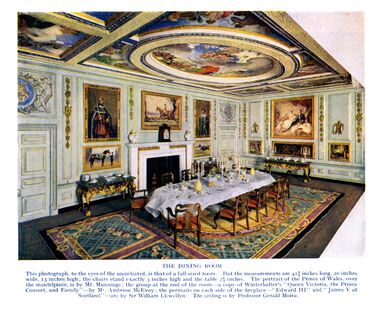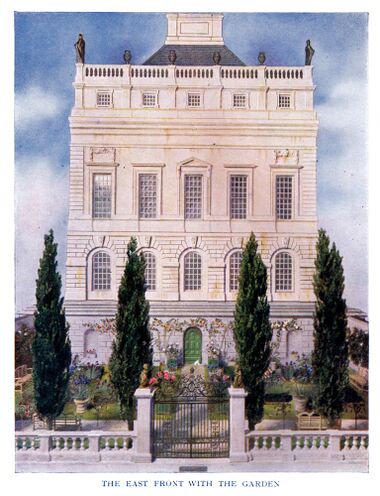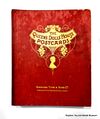Category:Queen Mary's Dolls' House
Postcard image of the house and garden, Raphael Tuck [image info]
The Dining Room [image info]
East Front with Garden [image info]
The Queen's Dolls House (later known, more specifically, as Queen Mary's Dolls' House), is an utterly extravagant 1:12-scale dollhouse designed to be the ultimate expression of how people (or at least, wealthy people and their household staff) lived in Britain in the 1920s, and a public showcase for the precision and artistry of British craftsmanship – not just a "museum piece" but a complete museum in its own right, executed in miniature.
The design and creation of the dollhouse and the commissioning of its contents for presentation to Queen Mary was organised by the architect Sir Edwin Lutyens (1869 - 1944), with the project starting in 1920, and finishing in 1924.
The dollhouse as a challenge in micro-engineering
Part time-capsule, part national monument, the creation of the dollhouse was approached not as the building of a conventional toy or a display model but as an engineering challenge, where extraordinarily extreme lengths were taken to try to make sure that as much of the house as possible was not only constructed using the same materials and techniques as the original, but also functioned correctly like the original. While it's not unusual for a dollhouse to have electric lighting, few are wired exactly like a real house, and have working lightswitches on the walls. Queen Mary's Dolls' House goes one step further by having miniature working Otis lifts, and even working plumbing – the miniature taps actually work and issue hot and cold water (slowly) ... or at least they did until some years after the dollhouse was finished, when the water-pipes – authentically! – furred up with calcium deposits, due to the water sitting in the pipes.
This "ultimate" approach to authenticity and detail, to an extent far beyond what any onlooker seeing the dollhouse on exhibition could ever hope to be able to see, extends to every book in the dollhouse library having fully handwritten pages, a collection of original paintings by well-known artists, and every miniature bottle of wine in the cellar being filled with wine and spirits of the correct type and correct vintage, carefully extracted from the real bottles with a syringe.
The Builders
The absurdly meticulous, "no-expense-spared" approach to the dollhouse was made possible by promoting the dollhouse as representing an entire national exhibition of British workmanship in miniature – it was presented as an opportunity for companies to have their products showcased, and to have the prestige of being chosen to allow their products to grace the country's ultimate, Royalty-endorsed dollhouse. This, of course meant that the companies producing miniatures of their normal work would go to extreme lengths to make the miniatures the ultimate that could be produced, and would then donate them to the dollhouse project free-of-charge, in exchange for being listed in the dollhouse's official inventory, and being able to brag about their association with the project in their promotional materials.
The "expense not spared" was therefore not actually Queen Mary's as she was getting the entire dollhouse and its contents as donations, free of charge. The strategy of assigning large companies little sections of the house meant that although the time and expense of producing each part was significant, it was not so large as to cripple any of the individual suppliers (or make too many of the invited donors turn down the opportunity to be associated with a Royal project). So (for instance) the garden was laid out by Gertrude Jekyll, who had worked closely with Lutyens designing gardens for the real buildings he'd designed, ceilings were painted by famous artists, the sewing machine was by Singer, the working lift with call buttons lift by Neville Maskelyne, an employee of Waygood-Otis (who was also a well known model railway engineer) the miniature guns with working breech-lock mechanisms and their cartridges (which might or might not actually be capable of firing) were supplied by Royal gunmakers James Purdey & Sons, and the model Lanchester limo had real miniature spoked wheels produced by car wheelmaker Rudge-Whitworth, fitted with miniature tyres supplied by Dunlop. Carpets were hand-woven at a weaving school for crippled children, and the house was painstakingly equipped with every item and piece of household equipment that would be found in a real house of the time, from working meat-mincers, to needlework sets and lawncare and gardening implements.
In some cases, the "donor" companies would pay third parties to produce the models for them before donating, so some of the cars were actually made by model engineers Twining Ltd, and a range of other expert British modelmakers would probably have probably have been involved.
The list of contents and their makers was so large that it had to be published in book form as a two-volume set, with the second volume dedicated just to the contents of the library.
Public display
The dollhouse was finished in 1924 and put on display at the British Empire Exhibition at Wembley, which was opened in by King George V and Queen Mary on 23 April 1924, with the first ever Royal live radio broadcast. The same Exhibition also showed off the new Flying Scotsman locomotive, and after a second exhibition year in 1925, the stadium was retained to become Wembley Football Stadium.
After the 1924 season at the Empire Exhibition, the dollhouse was sent to Kensington Olympia for the 1925 Ideal Home Exhibition, where it was put on display in a special pavilion, again designed by Lutyens.
Finally, in July 1925 it was installed in a special public display room designed by Lutyens at Windsor Castle, where it has been ever since.
The Doll's House
Over a million people have visited the Queen's Doll's House at Wembley, and over £25,000 has been thus raised for charities.
— , -, , The Children's Newspaper, 0286, , 1924-09-06
The Queen’s Doll’s House.
It is officially announced that the Queen’s Doll’s House will not be exhibited at the British Empire Exhibition this year. After being shown at the Ideal Home Exhibition at Olympia, it has gone to Windsor Castle, where a gallery has been prepared for it.
— , -, , The Architectural Review, Vol.57 Iss.343, , June 1925
See also:
External links
- Queen Mary's Dolls' House, homepage (royalcollection.org.uk)
- Queen Mary’s Dolls’ House (bbc.co.uk) - video (6 minutes)
- The Queen's Dolls' House is explored by Lucinda Lambton, by Emma Midgley, BBC Berkshire (news.bbc.co.uk)
- Lutyens's fabulous doll's house for Queen Mary (telegraph.co.uk)
- Queen Mary's five foot tall dollhouse (dailymail.co.uk)
Edwin Lutyens
British Empire Exhibition, 1924:
- British Empire Exhibitions 1924-1925 (20thcenturylondon.org.uk)
- 1924 British Empire Exhibition, Open University (http://www.open.ac.uk/researchprojects/makingbritain/content/1924-british-empire-exhibition)
Ideal Home Exhibition, 1925
Subcategories
This category has only the following subcategory.
T
- The Queens Dolls House Postcards (Raphael Tuck) (50 P, 52 F)
Pages in category ‘Queen Mary's Dolls' House’
The following 5 pages are in this category, out of 5 total.
Media in category ‘Queen Mary's Dolls' House’
The following 70 files are in this category, out of 70 total.
- Baby Carriages, Queens Dolls House (EBQDH 1924).jpg 2,000 × 1,353; 865 KB
- China Coffee Services, The Queens Dolls House postcards (Raphael Tuck 4500-7).jpg 1,600 × 1,015; 221 KB
- Corner of the Library, The Queens Dolls House postcards (Raphael Tuck 4501-8).jpg 1,008 × 1,600; 688 KB
- Dining Room Fireplace, The Queens Dolls House postcards (Raphael Tuck 4500-5).jpg 1,002 × 1,600; 624 KB
- Dining Room Sideboard, The Queens Dolls House postcards (Raphael Tuck 4500-6).jpg 1,600 × 1,017; 662 KB
- Dining Room, Queens Dolls House (EBQDH 1924).jpg 2,000 × 1,646; 1.23 MB
- Dining Room, The Queens Dolls House postcards (Raphael Tuck 4500-4).jpg 1,600 × 1,005; 609 KB
- Drawing Room Cabinet, The Queens Dolls House postcards (Raphael Tuck 4501-3).jpg 1,013 × 1,600; 282 KB
- Drawing Room or Grand Saloon, The Queens Dolls House postcards (Raphael Tuck 4501-1).jpg 1,600 × 1,004; 694 KB
- East Front with Garden, Queens Dolls House (EBQDH 1924).jpg 1,533 × 2,000; 1.08 MB
- Entrance Hall, The Queens Dolls House postcards (Raphael Tuck 4500-2).jpg 1,016 × 1,600; 554 KB
- Everybodys Book of the Queens Dolls House, cover (1924).jpg 907 × 1,200; 335 KB
- Everybodys Book of The Queens Dolls House, title page, 1924.jpg 744 × 1,024; 52 KB
- Garage, Queens Dolls House (EBQDH 1924).jpg 1,800 × 1,403; 727 KB
- Garden Entrance, The Queens Dolls House postcards (Raphael Tuck 4500-1).jpg 1,011 × 1,600; 557 KB
- Grand Piano in Drawing Room, The Queens Dolls House postcards (Raphael Tuck 4501-2).jpg 1,600 × 1,013; 391 KB
- Hall Table and Chairs, The Queens Dolls House postcards (Raphael Tuck 4500-3).jpg 1,600 × 1,015; 297 KB
- Her Majestys Boudoir, The Queens Dolls House postcards (Raphael Tuck 4503-1).jpg 1,600 × 997; 672 KB
- Her Majestys Dressing Table, The Queens Dolls House postcards (Raphael Tuck 4503-7).jpg 1,600 × 1,016; 295 KB
- Housemaids Closet, The Queens Dolls House postcards (Raphael Tuck 4504-6).jpg 1,600 × 1,008; 519 KB
- In the Linen Room, The Queens Dolls House postcards (Raphael Tuck 4503-8).jpg 1,600 × 1,002; 246 KB
- Lanchester Saloon Limousine, Queens Dolls House (EBQDH 1924).jpg 1,800 × 1,262; 677 KB
- Lawn Mower, The Queens Dolls House (EBQDH 1924).jpg 1,600 × 1,037; 430 KB
- Main Front, The Queens Dolls House (EBQDH 1924).jpg 1,157 × 1,600; 563 KB
- Nursery Piano and Gramophone, The Queens Dolls House postcards (Raphael Tuck 4504-3).jpg 1,600 × 1,024; 321 KB
- Nursery Toys, The Queens Dolls House postcards (Raphael Tuck 4504-5).jpg 1,600 × 1,006; 276 KB
- Perambulator and Motor Cycle, The Queens Dolls House postcards (Raphael Tuck 4505-3).jpg 1,600 × 1,016; 260 KB
- Princess Royals Bedroom, The Queens Dolls House postcards (Raphael Tuck 4502-7).jpg 1,012 × 1,600; 586 KB
- Queen Marys Dolls House, cover, ISBN 0896598764.jpg 1,200 × 959; 264 KB
- Rudge Motor-Cycle and Sidecar, Queens Dolls House (EBQDH 1924).jpg 1,800 × 1,256; 680 KB
- Souvenir Book of the Queens Dolls House, cover (1924).jpg 1,178 × 1,800; 560 KB
- Stores in Cellar, The Queens Dolls House postcards (Raphael Tuck 4505-6).jpg 1,005 × 1,600; 521 KB
- Sunbeam Tourer car, exhibition model, Twining Models (WM 1927).jpg 1,600 × 1,135; 670 KB
- The Book of the Queens Dolls House, vols 1 and 2, ad (EBQDH 1924).jpg 839 × 1,024; 131 KB
- The Kings Bathroom, The Queens Dolls House postcards (Raphael Tuck 4502-2).jpg 1,008 × 1,600; 488 KB
- The Kings Bedroom, The Queens Dolls House postcards (Raphael Tuck 4502-1).jpg 1,600 × 990; 625 KB
- The Kings Library Table, The Queens Dolls House postcards (Raphael Tuck 4501-7).jpg 1,600 × 1,027; 356 KB
- The Kitchen Table, The Queens Dolls House postcards (Raphael Tuck 4504-8).jpg 1,600 × 1,024; 330 KB
- The Library, The Queens Dolls House postcards (Raphael Tuck 4501-5).jpg 1,600 × 1,006; 712 KB
- The Queens Bathroom, The Queens Dolls House postcards (Raphael Tuck 4502-4).jpg 1,011 × 1,600; 551 KB
- The Queens Bedroom, The Queens Dolls House postcards (Raphael Tuck 4502-3).jpg 1,600 × 1,013; 594 KB
- The Queens Dolls House Postcard Album (Raphael Tuck).jpg 1,675 × 2,000; 609 KB
- The Queens Dolls House Postcard boxed set (Raphael Tuck).jpg 1,483 × 2,000; 1,015 KB
- The Queens Dolls House Postcards, logo artwork (Raphael Tuck).jpg 1,303 × 2,000; 332 KB
- The Queens Dolls House Postcards, postcard album, introduction (Raphael Tuck).jpg 2,000 × 1,126; 517 KB
- The Royal Kitchen, The Queens Dolls House postcards (Raphael Tuck 4504-7).jpg 1,600 × 1,004; 537 KB
- The Royal Nursery, The Queens Dolls House postcards (Raphael Tuck 4504-1).jpg 1,600 × 1,006; 546 KB
- Upper Hall, Queens Dolls House (EBQDH 1924).jpg 932 × 1,200; 350 KB
- Waygood-Otis Lifts and Framework, Queens Dolls House (EBQDH 1924).jpg 1,200 × 2,000; 311 KB
- West End of the Dolls House, The Queens Dolls House (EBQDH 1924).jpg 926 × 1,200; 368 KB
- Wine Cellar, The Queens Dolls House postcards (Raphael Tuck 4500-8).jpg 1,013 × 1,600; 583 KB











































































